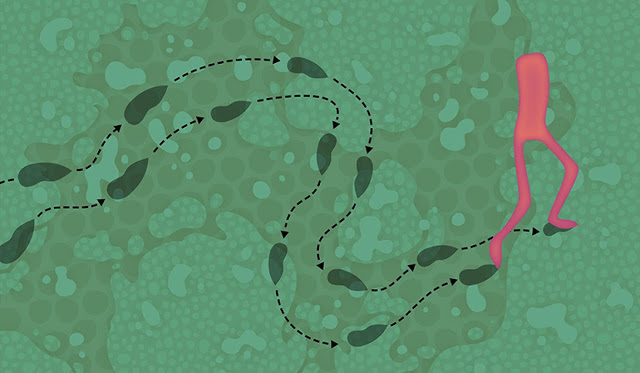| Online: | |
| Visits: | |
| Stories: |
Nanoscale Machine Built from DNA – ”Could Roam the Human Body”
Nanoscale Autonomous Walking Machine Built from DNA – ”Could Roam the Human Body”
11/02/2015
Graphic by Jenna Luecke Researchers at The University of Texas at Austin have developed a nanoscale machine made of DNA that can randomly walk in any direction across bumpy surfaces.
Future applications of such a DNA walker might include a cancer detector that could roam the human body searching for cancerous cells and tagging them for medical imaging or drug targeting.
The study by researchers Cheulhee Jung, Peter B. Allen and Andrew Ellington, published this week in the journal Nature Nanotechnology, developed DNA machines that were able to walk, unprogrammed and in different directions, over a DNA-coated surface.
Previously, nanoparticle walkers were only able to walk on precise and programmed one- and two-dimensional paths. This walker was able to move 36 steps, and its movement in a random fashion is different from movement seen in other studies.
“This is an important step forward in developing nanoscale nucleic acid machines that can autonomously act under a variety of conditions, including in the body,” said Ellington, professor in the Department of Molecular Biosciences and member of the UT Center for Systems and Synthetic Biology.
“DNA nanotechnology is especially interesting because it explores the world of ‘matter computers,’ where computations (including walking) are carried out by physical objects, rather than by electronic or magnetic shuttles.
DNA walkers may eventually allow protective cells to walk the surface of organs, constantly computing whether a cancer is present.”
More immediate practical applications may include deploying the DNA walker in the body so that it can amplify signals from cancer cells to make them more easily identified and targeted by doctors.
There also may be implications for future delivery of nanoscale therapeutics. Although it may be a long march from diagnosing cancer to curing it, “All breakthroughs begin with baby steps. Only in this case, they are the steps of a DNA walker,” said co-author Jung.
The walker is made from a single piece of DNA with two legs connected by a torso. Like a human, it moves by putting one leg forward, then lifting the other leg and putting it forward. The walker autonomously and randomly decides where to put its leg on each step. The study demonstrated that as the nanoscale machine walked, it did not go over the same area twice.
This research was funded by the National Institutes of Health, the Welch Foundation and the U.S. Department of Defense’s Office of Naval Research through a National Security, Science and Engineering Faculty Fellowship. Source: University of Texas at Austin.
http://www.techswarm.com/2015/11/nanoscale-autonomous-walking-machine.html
NESARA- Restore America – Galactic News
Source: http://nesaranews.blogspot.com/2015/11/nanoscale-machine-built-from-dna-could.html





